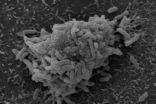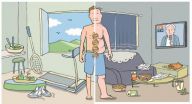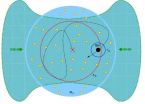(Press-News.org) ANN ARBOR, Mich. – Childhood obesity remains the top health concern for children in 2014, but when asked about national concerns, adults put school violence and gun-related injuries in the top 10, according to a new University of Michigan C.S. Mott Children's Hospital National Poll on Children's Health.
In the poll's annual top 10 list, a nationwide sample of adults were asked to identify the biggest health concerns for kids in their communities, as well as kids nationwide. Overall, childhood obesity is rated at the top of both lists: 29 percent of adults said obesity is a 'big problem' for children in their local communities and 55 percent said it is 'big problem' across the country.
The top 10 rankings for 2014 are:
LOCAL COMMUNITY
Childhood obesity-29 %
Smoking and tobacco use-26%
Drug Abuse-26%
Bullying-23 %
Stress-22%
Alcohol abuse-19%
Internet safety-18%
Child abuse and neglect-18%
Teen pregnancy-16%
Not enough physical activity options-15%
ACROSS THE U.S.
Childhood obesity-55%
Bullying-52%
Drug Abuse-49%
Smoking and tobacco use-47%
School violence-44%
Child abuse and neglect-42%
Alcohol abuse-41%
Internet safety-40%
Gun-related injuries-39%
Teen pregnancy-37%
"Obesity remains a top child health problem overall, which has been a persistent concern in our annual top 10 polls along with others like bullying, smoking and drug abuse," says Matthew M. Davis, M.D., M.A.P.P., director of the C.S. Mott Children's Hospital National Poll on Children's Health.
"But this year's top 10 lists differ in key ways. School violence and gun-related injuries are on the list of big child health problems from a national perspective, but not a local community perspective."
Recent shootings and other instances of violence in schools may have prompted concern among adults from a national perspective, says Davis, who also is professor of pediatrics, internal medicine, public policy and health management and policy at the U-M Medical School, Gerald R. Ford School of Public Policy and School of Public Health.
The poll shows a strong link between many of the top 10 child health concerns to health behaviors of children and their families, says Davis, also a member of the U-M Institute for Healthcare Policy and Innovation. These concerns indicate that the public understands the powerful role of behavior in health – in terms of short-term impact and long-term consequences. Childhood obesity is a good example.
"Recent data released by the Centers for Disease Control and Prevention indicate that rates of obesity in early childhood are decreasing in some states," says Davis.
"But we know obesity among children remains substantially higher than it was in generations past. So this poll reminds us that much of the public recognizes the need to keep working hard on this problem."
Davis says he hopes the results of this poll help health professionals, community leaders and elected representatives prioritize the threats to children's health in their own communities.
"We need to work hard together on these issues of greatest concern to the public, and take note of the particular national concern about school violence and gun-related injuries so we can address how to improve and safeguard our children's health," he says.
INFORMATION:
Broadcast-quality video is available on request. See the video here: https://www.youtube.com/watch?v=QbNag5Oc_Ms
Full report:
C.S. Mott Children's Hospital National Poll on Children's Health
Website: Check out the Poll's website: MottNPCH.org. You can search and browse over 80 NPCH Reports, suggest topics for future polls, share your opinion in a quick poll, and view information on popular topics. The National Poll on Children's Health team welcomes feedback on the website, including features you'd like to see added. To share feedback, e-mail NPCH@med.umich.edu.
Facebook: http://www.facebook.com/mottnpch
Twitter: @MottNPCH
Additional resources:
Childhood Obesity: http://www.cdc.gov/healthyweight/children/
Bullying: StopBullying.gov: http://www.stopbullying.gov
Drug Abuse: The Partnership for a Drug Free America: http://www.drugfree.org/
Smoking and Tobacco Use: Protecting Your Child from Tobacco Use: http://www.cdc.gov/features/BackToSchool/
School Violence: http://www.pta.org/schoolviolence
Child Abuse and Neglect: National Parent Helpline: http://www.nationalparenthelpline.org/
Alcohol Abuse: Stop Underage Drinking: https://www.stopalcoholabuse.gov/parents.aspx
Internet Safety: Enough is Enough - Making the Internet Safer for Children and Families: https://www.commonsensemedia.org/
Gun related Injuries: http://kidshealth.org/parent/firstaid_safe/home/gun_safety.html
Teen Pregnancy: The National Campaign to Prevent Teen and Unplanned Pregnancy: http://www.thenationalcampaign.org/
Purpose/Funding: The C.S. Mott Children's Hospital National Poll on Children's Health – based at the Child Health Evaluation and Research Unit at the University of Michigan and funded by the Department of Pediatrics and Communicable Diseases and the University of Michigan Health System – is designed to measure major health care issues and trends for U.S. children.
Data Source: This report presents findings from a nationally representative household survey conducted exclusively by GfK Custom Research, LLC (GfK) for C.S. Mott Children's Hospital via a method used in many published studies. The survey was administered in June 2014 to a randomly selected, stratified group of adults age 18 or older (n=2,027), from GfK's web-enabled KnowledgePanel®, that closely resembles the U.S. population. The sample was subsequently weighted to reflect population figures from the Census Bureau. The survey completion rate was 58 percent among panel members contacted to participate. The margin of error is 1 to 4 percentage points and higher among subgroups.
Findings from the U-M C.S. Mott Children's Hospital National Poll on Children's Health do not represent the opinions of the investigators or the opinions of the University of Michigan.
School violence, gun-related injury among top 10 child health concerns nationally
Childhood obesity still at the top in annual top 10 list of childhood health concerns, according to U-M's National Poll on Children's Health
2014-08-11
ELSE PRESS RELEASES FROM THIS DATE:
Inequality -- a key issue of economic research
2014-08-11
In the aftermath of the global financial crisis and the ensuing economic and political disruptions, inequality has re-emerged as a central focus of public debate. The drivers of rising inequality of income and wealth and the various scientific models for counteractive measures will be among the central topics debated among 17 Nobel Laureates in Economic Sciences and approximately 450 aspiring young economists from more than 80 countries in Lindau, Germany, next week. The 5th Lindau Meeting on Economic Sciences will bring them together for a unique dialogue across generations, ...
Clues emerge to genetic architecture of cognitive abilities in children
2014-08-11
How genes affect intelligence is complicated. Multiple genes, many yet unknown, are thought to interact among themselves and with environmental factors to influence the diverse abilities involved in intelligence.
A large new genetic study in thousands of children and adolescents offers early glimpses of the overall patterns and connections among cognitive abilities such as language reasoning, reading skill and types of memory. The findings may lead to new tools in understanding human cognitive development and neuropsychiatric disorders.
"This research is one of the ...
More intensive interventions needed to combat severe obesity in teens
2014-08-11
New Rochelle, NY, August 11, 2014 -- Nearly 6% of all children and teens in the U.S. are severely obese, and the prevalence of severe obesity is increasing faster than that of moderate obesity or overweight. This is an alarming trend as about 90% of these youths will grow up to be obese adults. The serious health problems associated with severe obesity and the poor long-term prognosis and quality of life projected for these children and teens demand more serious consideration of safe and effective treatment options that go beyond diet and lifestyle modifications, as proposed ...
Pairing old technologies with new for next-generation electronic devices
2014-08-11
UCL scientists have discovered a new method to efficiently generate and control currents based on the magnetic nature of electrons in semi-conducting materials, offering a radical way to develop a new generation of electronic devices.
One promising approach to developing new technologies is to exploit the electron's tiny magnetic moment, or 'spin'. Electrons have two properties – charge and spin – and although current technologies use charge, it is thought that spin-based technologies have the potential to outperform the 'charge'-based technology of semiconductors for ...
Sugary bugs subvert antibodies
2014-08-11
A lung-damaging bacterium turns the body's antibody response in its favor, according to a study published in The Journal of Experimental Medicine.
Pathogenic bacteria are normally destroyed by antibodies, immune proteins that coat the outer surface of the bug, laying a foundation for the deposition of pore-forming "complement" proteins that poke lethal holes in the bacterial membrane. But despite having plenty of antibodies and complement proteins in their bloodstream, some people can't fight off infections with the respiratory bacterium Pseudomonas aeruginosa. And chronic ...
Tackling liver injury
2014-08-11
A new drug spurs liver regeneration after surgery, according to a paper published in The Journal of Experimental Medicine.
Liver cancer often results in a loss of blood flow and thus oxygen and nutrients to the liver tissue, resulting in deteriorating liver function. Although the diseased part of the liver can often be surgically removed, the sudden restoration of blood flow to the remaining liver tissue can trigger inflammation—a process known as ischemia reperfusion injury (IRI). IRI results in part from the deposition of immune proteins called complement on the surface ...
'Seeing' through virtual touch is believing
2014-08-11
Visual impairment comes in many forms, and it's on the rise in America.
A University of Cincinnati experiment aimed at this diverse and growing population could spark development of advanced tools to help all the aging baby boomers, injured veterans, diabetics and white-cane-wielding pedestrians navigate the blurred edges of everyday life.
These tools could be based on a device called the Enactive Torch, which looks like a combination between a TV remote and Captain Kirk's weapon of choice. But it can do much greater things than change channels or stun aliens.
Luis ...
Aberrant mTOR signaling impairs whole body physiology
2014-08-11
The protein mTOR is a central controller of growth and metabolism. Deregulation of mTOR signaling increases the risk of developing metabolic diseases such as diabetes, obesity and cancer. In the current issue of the journal Proceedings of the National Academy of Sciences, researchers from the Biozentrum of the University of Basel describe how aberrant mTOR signaling in the liver not only affects hepatic metabolism but also whole body physiology.
The protein mTOR regulates cell growth and metabolism and thus plays a key role in the development of human disorders. In the ...
Not only in DNA's hands
2014-08-11
Blood stem cells have the potential to turn into any type of blood cell, whether it be the oxygen-carrying red blood cells, or the many types of white blood cells of the immune system that help fight infection. How exactly is the fate of these stem cells regulated? Preliminary findings from research conducted by scientists from the Weizmann Institute and the Hebrew University are starting to reshape the conventional understanding of the way blood stem cell fate decisions are controlled thanks to a new technique for epigenetic analysis they have developed. Understanding ...
All-you-can-eat at the end of the universe
2014-08-11
At the ends of the Universe there are black holes with masses equaling billions of our sun. These giant bodies – quasars – feed on interstellar gas, swallowing large quantities of it non-stop. Thus they reveal their existence: The light that is emitted by the gas as it is sucked in and crushed by the black hole's gravity travels for eons across the Universe until it reaches our telescopes. Looking at the edges of the Universe is therefore looking into the past. These far-off, ancient quasars appear to us in their "baby photos" taken less than a billion years after the Big ...
LAST 30 PRESS RELEASES:
Making lighter work of calculating fluid and heat flow
Normalizing blood sugar can halve heart attack risk
Lowering blood sugar cuts heart attack risk in people with prediabetes
Study links genetic variants to risk of blinding eye disease in premature infants
Non-opioid ‘pain sponge’ therapy halts cartilage degeneration and relieves chronic pain
AI can pick up cultural values by mimicking how kids learn
China’s ecological redlines offer fast track to 30 x 30 global conservation goal
Invisible indoor threats: emerging household contaminants and their growing risks to human health
Adding antibody treatment to chemo boosts outcomes for children with rare cancer
Germline pathogenic variants among women without a history of breast cancer
Tanning beds triple melanoma risk, potentially causing broad DNA damage
Unique bond identified as key to viral infection speed
Indoor tanning makes youthful skin much older on a genetic level
Mouse model sheds new light on the causes and potential solutions to human GI problems linked to muscular dystrophy
The Journal of Nuclear Medicine ahead-of-print tip sheet: December 12, 2025
Smarter tools for peering into the microscopic world
Applications open for funding to conduct research in the Kinsey Institute archives
Global measure underestimates the severity of food insecurity
Child survivors of critical illness are missing out on timely follow up care
Risk-based vs annual breast cancer screening / the WISDOM randomized clinical trial
University of Toronto launches Electric Vehicle Innovation Ontario to accelerate advanced EV technologies and build Canada’s innovation advantage
Early relapse predicts poor outcomes in aggressive blood cancer
American College of Lifestyle Medicine applauds two CMS models aligned with lifestyle medicine practice and reimbursement
Clinical trial finds cannabis use not a barrier to quitting nicotine vaping
Supplemental nutrition assistance program policies and food insecurity
Switching immune cells to “night mode” could limit damage after a heart attack, study suggests
URI-based Global RIghts Project report spotlights continued troubling trends in worldwide inhumane treatment
Neutrophils are less aggressive at night, explaining why nighttime heart attacks cause less damage than daytime events
Menopausal hormone therapy may not pose breast cancer risk for women with BRCA mutations
Mobile health tool may improve quality of life for adolescent and young adult breast cancer survivors
[Press-News.org] School violence, gun-related injury among top 10 child health concerns nationallyChildhood obesity still at the top in annual top 10 list of childhood health concerns, according to U-M's National Poll on Children's Health






